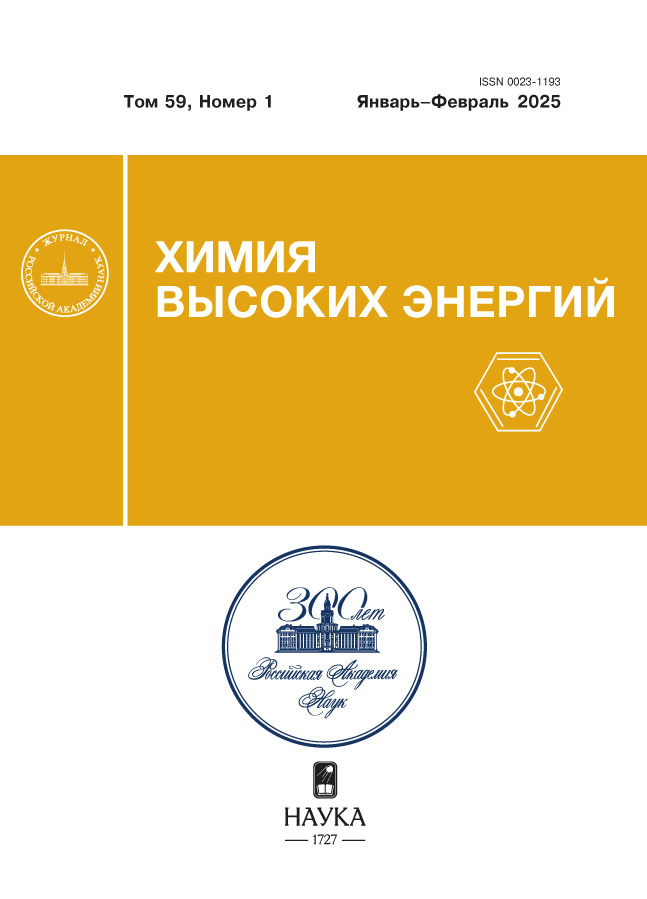Spectral and photochemical properties of dipyrenylcyclobutanes formed in the [2+2]-photocycloaddition reaction from biphotochromic dyads
- 作者: Budyka M.F.1, Li V.M.1, Gavrishova T.N.1
-
隶属关系:
- Federal Research Center of Problems of Chemical Physics and Medicinal Chemistry of the RAS
- 期: 卷 59, 编号 1 (2025)
- 页面: 26-38
- 栏目: ФОТОХИМИЯ
- URL: https://innoscience.ru/0023-1193/article/view/684666
- DOI: https://doi.org/10.31857/S0023119325010048
- EDN: https://elibrary.ru/SPMLKY
- ID: 684666
如何引用文章
详细
The properties of dipyrenylcyclobutanes CB10 and CBoX, which are products of the [2+2]-photocycloaddition reaction (PCA) of the corresponding biphotochromic dyads D10 and DoX, have been studied. The absorption and fluorescence spectra of cyclobutane CBoX revealed the presence of different types of pyrene substituents, with strong and weak interactions in the ground S0 and excited S1 states. In both cyclobutanes, energy transfer (ET) from the pyrenyl substituents to the cyclobutane rings is observed, initiating the cyclobutane opening reaction (retro-PCA), which occurs via a predissociation mechanism. The photochromic pair “D10-CB10” is an example of a new type of photochrome operating by the mechanism of the PCA reaction and can function as a two-channel color-correlated fluorescent photoswitch.
全文:
作者简介
M. Budyka
Federal Research Center of Problems of Chemical Physics and Medicinal Chemistry of the RAS
编辑信件的主要联系方式.
Email: budyka@icp.ac.ru
俄罗斯联邦, Chernogolovka
V. Li
Federal Research Center of Problems of Chemical Physics and Medicinal Chemistry of the RAS
Email: budyka@icp.ac.ru
俄罗斯联邦, Chernogolovka
T. Gavrishova
Federal Research Center of Problems of Chemical Physics and Medicinal Chemistry of the RAS
Email: budyka@icp.ac.ru
俄罗斯联邦, Chernogolovka
参考
- Kirkus M., Janssen R.A.J., Meskers S.C.J. // J. Phys. Chem. A. 2013. V. 17. P. 4828.
- Margulies E.A., Shoer L.E., Eaton S.W., Wasielewski M.R. // Phys. Chem. Chem. Phys. 2014. V. 16. P. 23735.
- Long S., Wang Y., Vdovic S., Zhou M., Yan L., Niu Y. et al. // Phys. Chem. Chem. Phys. 2015. V. 17. P. 18567.
- Cho D.W., Fujitsuka M., Sugimoto A., Majima T. // J. Phys. Chem. A. 2008. V. 112. P. 7208.
- Wang S., Bohnsack M., Megow S., Renth F., Temps F. // Phys. Chem. Chem. Phys. 2019. V. 21. P. 2080.
- Kucukoz B., Adinarayana B., Osuka A., Albinsson B. // Phys. Chem. Chem. Phys. 2019. V. 21. P. 16477.
- Letrun R., Lang B., Yushchenko O., Wilcken R., Svechkarev D., Kolodieznyi D. et al. // Phys. Chem. Chem. Phys. 2018. V. 20. P. 30219.
- Chahal M.K., Liyanage A., Gobeze H.B., Payne D.T., Ariga K., Hill J.P., D’Souza F. // Chem. Commun. 2020. V. 56. P. 3855.
- Liang C.K., Desvergne J.P., Bassani D.M. // Photochem. Photobiol. Sci. 2014. V. 13. P. 316.
- Perrier A., Maurel F., Jacquemin D. // Acc. Chem. Res. 2012. V. 45. P. 1173.
- Doddi S., Ramakrishna B., Venkatesha Y., Bangl P.R. // RSC Adv. 2015. V. 5. P. 56855.
- Kim D., Park S.Y. // Optical Mater. 2018. P. 1800678.
- Szacilowski K. // Chem. Rev. 2008. V. 108. P. 3481.
- Будыка М.Ф. // Успехи химии. 2017. Т. 86. С. 181.
- Andreasson J., Pischel U. // Coord. Chem. Rev. 2021. V. 429. P. 213695.
- Будыка М.Ф., Поташова Н.И., Гавришова Т.Н., Ли В.М., Гак В.Ю., Гринева И.А. // Химия высоких энергий. 2018. Т. 52. С. 204.
- Будыка М.Ф., Ли В.М., Гавришова Т.Н. // Химия высоких энергий. 2024. Т. 58, С. 77.
- Budyka M.F., Fedulova J.A., Gavrishova T.N., Li V.M., Potashova N.I., Tovstun S.A. // Phys. Chem. Chem. Phys. 2022. V. 24. P. 24137
- Bera S., Bera A., Banerjee D. // Org. Lett. 2020. V. 22. P. 6458.
- Sahu K.B., Ghosh S., Banerjee M., Maity A., Mondal S., Paira R. et al. // Med. Chem. Res. 2013. V. 22. P. 94.
- Будыка М.Ф., Гавришова Т.Н., Ли В.М., Дозморов С.А. // Изв. АН. Сер.хим. 2023. Т. 72. С. 2013.
- Winnik F.M. // Chem. Rev. 1993. V. 93. P. 587.
- Siu H., Duhamel J. // J. Phys. Chem. B. 2008. V. 112. P. 15301.
- Seixas de Melo J., Costa T., Francisco A., Macanita A.L., Gago S., Goncalves I.S. // Phys. Chem. Chem. Phys. 2007. V. 9. P. 1370.
- Dong D.C., Winnik M.A. // Photochem. Photobiol. 1982. V. 35. P. 17.
- Seixas de Melo J., Costa T., Miguel M.G., Lindman B., Schillen K. // J. Phys. Chem. B. 2003. V. 107. P. 12605.
- Pomerantsev A.L., Chemometrics in Excel. Hoboken, John Wiley & Sons Inc., 2014.
- Fischer E. // J. Phys. Chem. 1967. V. 71. P. 3704.
- Perrier A., Maurel F., Jacquemin D. // Acc. Chem. Res. 2012. V. 45. P. 1173.
- Budyka M.F., Gavrishova T.N., Li V.M., Tovstun S.A. // Spectr. Acta Part A. 2024. V. 320. P. 124666.
- Braslavsky S.E., Fron E., Rodriguez H.B., Roman E.S., Scholes G.D., Schweitzer G. et al. // Photochem. Photobiol. Sci. 2008. V. 7. P. 1444.
- Chung J.W., You Y., Huh H.S., An B.K., Yoon S.J., Kim S.H. et al. // J. Am. Chem. Soc. 2009. V.131. P. 8163.
补充文件




















